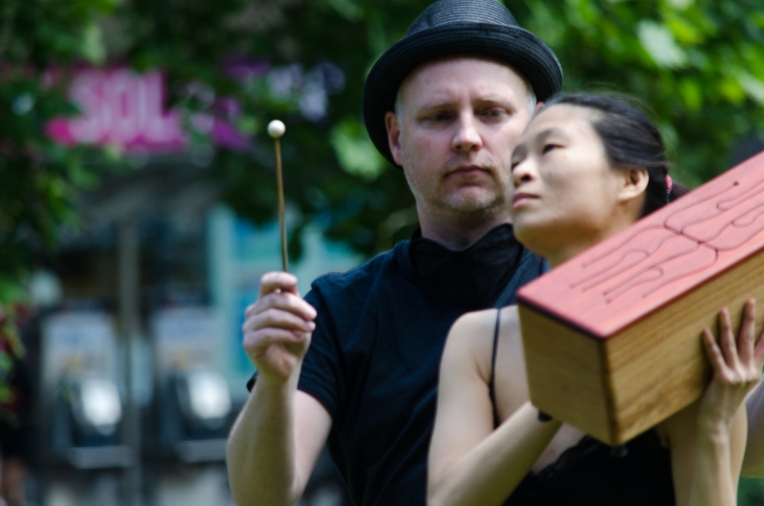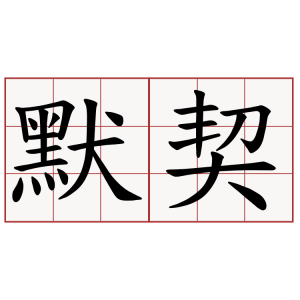
Clinton Green is Melbourne-based artist who has worked at the fringes of music and noise since the early 1990s. He has worked with new approaches to electric guitar (recording and performing under the moniker of Undecisive God), modification/hacking of turntables as dynamic generators of random sonic materials, and in various forms of free improvisation. He is also a published writer with a focus on the history of experimental music in Australia. He holds a Graduate Diploma in Music Studies from Monash University. Website.
Chun-liang and I first met at the General Assembly of Interested Parties (GAIP) event, at Testing Grounds in Melbourne. It was October 2014. Conjured into some kind of decentralised-yet-coherent existence by Ren Walters, GAIP is a difficult thing to describe for those who have not attended/participated. Put simply, it is a day-long event of multi-disciplinary performances with no schedule or designated performance areas. On this occasion, I did a performance/reading of John Cage’s Lecture On Nothing, as well as some improvised moments on a small turntable, but for a large part of the day I just observed what others were doing, and most importantly made connections with other artists present.
I remember very well when Chun-liang first arrived at Testing Grounds. I was in the small office, standing up against one of the walls, watching/listening to a performance taking place in there. Chun-liang came in and said hello to everyone who was present; hugging those she knew. She came up to me, introduced herself, and shook my hand. I did not know her at all prior to this, and her forthright introduction made an impression on me. I found out later that she knew something of me from seeing me perform previously, but I was no less impressed by her openness. As a relatively shy person, such “cold introductions” are not easy for me!
Soon after, Chun-liang was flitting around outside, dancing on her own and with others, trying to draw other people into her dance. She danced for a long time with Michael McNab, and I sat and watched them. Various other GAIP-ish things were happening with different instruments and actions, and I got out a turntable and stood there with it playing in my hands. Chun-liang was interacting with various people performing and standing around; at one point she came over and laid her hair across my turntable, took my hat and put it on other people. She danced for a very long time, maybe an hour-plus. There was a lot of joy and innocence in her performance that day. Already I was beginning to understand that she is more than a dancer, that her interaction with other people was just as important. Here is some video of Chun-liang, myself and other GAIPites from that day.
After I had performed the Lecture On Nothing, I was back inside the small office watching Elnaz, Shani, Scotty and some others do an improvised theatrical performance (I would fall in with this crew to be part of Elnaz’s play within a week as well). I was holding the book, Silence, that I had been reading Cage’s lecture from. Chun-liang stood with me as we watched the performance. I opened the book at random and with an exaggerated gesture pointed out a line of text to Chun-liang. The text was ‘Art comes only from within’. I think we smiled at each other. Then Chun-liang pressed her fingers against the centre of my chest, at my heart. For me, this was when our 默契 partnership began.

Later, we sat outside and chatted in ‘non-performance’ mode. Chun-liang told me how she’s seen me perform previously (at Current, with other dancers) and wondered if we could do an improvised performance together. I had been impressed with what I’d seen of Chun-liang that day, so I was thrilled that she wanted to work with me, and we started plotting our first performance there and then. I think we both felt that we had made an important connection and had lots of common ideas about what we wanted to explore and achieve.
After our first performance the following month, we both felt we wanted to continue working together, and that it would be good to have a name for our group/partnership, although neither of us could initially come up with an anything that seemed right. Then we were talking about The Necks, and I was saying how they never discuss what they going to do before each performance, but it always sounds very much like The Necks. Chun-liang said there is a phrase for this unspoken agreement in Mandarin -默契. I said that sounds like a good way to describe our partnership in performance, and maybe that should be our name. Chun-liang was thinking the same thing.
Chun-liang Liu is a female Taiwanese artist who is currently investigating the body in the public spaces in Melbourne and Taipei. Her works take the phenomenological perspectives as a lens to look into the sense of being via field observation and live interaction. Recent performing works include Library Dreams (with Clinton Green and Hi-God People) and SLV-Wake (with Clinton Green and Shani Holmes). She’s currently studying at the Centre for Ideas, Victorian College of the Arts for Interdisciplinary Arts Practice (Masters by Research). Chun-liang is interested in different forms of “encounter”, especially creating different frictions by body movements and interaction.
I came to Melbourne at the end of summer. Soon I realized that I should have brought more winter wear than summer’s (always the same mistake). I didn’t know much about the physicality of Melbourne folks; for me, the winter in Melbourne was freezing and depressing. A newbie to the art world, I was and still am clueless most of the time. Out of sheer chance with an invitation from the lovely dancer Janette Hoe, I went to Current before winter really came. Walking from the city to Fitzroy with my google map and a kind pedestrian’s help, I got to witness Janette Hoe’s performance. But most importantly, I saw Clinton Green. He was very persistent, almost careless to others it seemed to me. My comment on his performance was that “if you persist enough, bad turns out to be good.”
At the next Current I was lucky enough to perform in the afternoon. And I saw the last two performances in the evening; late night, dimmed light, white walls with shadows in Conduit Arts. Clinton was there again, this time he seemed to soften a little bit.
I was a very shy person inside (though I tried my best to be open). Two performances, what I got was his first name and nothing else.
There’s something about Clinton’s performance that caught me eye. It is the relationship between failure and success. His attempt in making sounds and music with found objects create a lot of unknown parameters in the performances, you get to see the attempt, and sometimes the failure.
And then there came GAIP at Testing Grounds again. I went there, saw lots of strangers, and did what I thought an Australian was supposed to do, I said hi to everyone.
Clinton was there, had his back to the wall. I said hi to him.
I danced on and off for a few hours, with lots of intriguing figures including Michael McNab (who taught me a little bit of French while I spoke to him both in Mandarin and Taiwanese). But most importantly I sat down beside Clinton in the afternoon. I guess we were more or less knackered. I told Clinton that I was researching public spaces, and especially the State Library. I always felt that events like Current and GAIP were marvelous in the conversation between artists. And I wondered what would happen if we presented ourselves in daily social settings?
 And then came Library Dreams with the Hi-God People, Clinton Green and I. For some small reasons I called Clinton after Library Dreams and we had a brief chat of our reflections on the performance. We also discussed how we liked that event and the challenge behind it for the fact that we were after all social animals, and were conformed to the norms no matter how much we wanted to break them. I was going back to Taiwan (where I am at the moment) and we said that we had to have another performance. And then came SLV-Wake.
And then came Library Dreams with the Hi-God People, Clinton Green and I. For some small reasons I called Clinton after Library Dreams and we had a brief chat of our reflections on the performance. We also discussed how we liked that event and the challenge behind it for the fact that we were after all social animals, and were conformed to the norms no matter how much we wanted to break them. I was going back to Taiwan (where I am at the moment) and we said that we had to have another performance. And then came SLV-Wake.
There was a partnership forming quickly via emails, Facebook, and real-life meetings. I was studying sociology and political science before I decided to “try to be” an artist. I had day jobs and lots of small jobs that were mainly related to what I was trained to be, a sociologist, or a person who sees the world through a relational lens. What brought Clinton and I together, besides the connections we immediately had during the performances, was the fact that we were pretty much social beings as well. I was an international student struggling to have a career in a foreign place with a background that has absolutely nothing to do with the art world. Even if I’ve been creating and dancing, I could only say that I am a person who dances, and creates. What brought us together was the acknowledgement of that barrier, that unsaid and unknown fear, and the small resistance towards what has existed in the art world. Though in my case it’s only an imaginary one because I was really, and still am, fairly ignorant towards almost everything. I had a very strong interest in observing and finding connections. I guess that’s what brought Clinton and I together as partners.
I told Clinton about 默契 when I was ready to go back to Taiwan. I was preparing myself to re-experience my own country again while I was adjusting to another world that’s on the other end of the globe, the Southern hemisphere.
Australia was not that different from Taiwan. We had long histories in colonization. We were all privileged immigrants (in Australia the English-speaking population, and in Taiwan the Mandarin and possibly Taiwanese speaking population). We all had problems in facing these histories. People barely know anything about Taiwan in Australia. And, even if Australia has a more stable status quo regarding political power, there are obviously a lot of problems between indigenous communities and the so-called general public (which in my opinion was worryingly vague in every sense).
Beyond all those difficulties, our own ignorance in each other’s histories, our own ignorance towards our own history, the occasional language barriers, we knew what we were talking about most of the time. When I disagree with him, I told him. If I pissed Clinton off, he told me. I haven’t met his family, but I’ve heard his wife’s singing, seen his daughter’s picture, and said hi to his two cats and one dog.
All in all that’s what 默契 is about. If people could connect that fast, wouldn’t it be nice to extend that connection to others?
